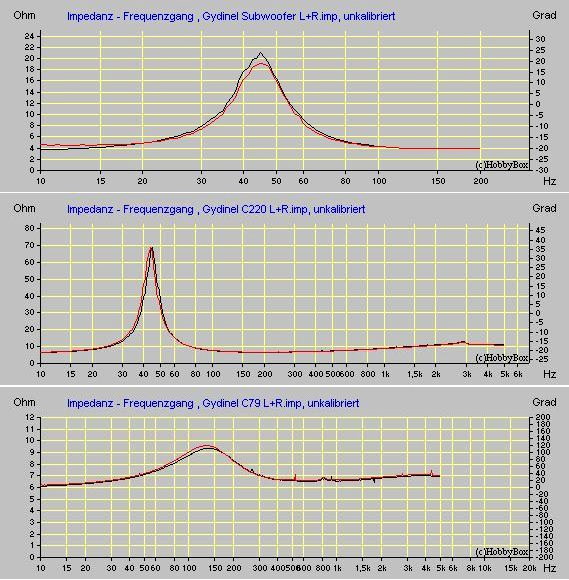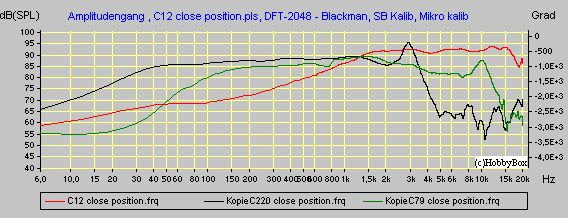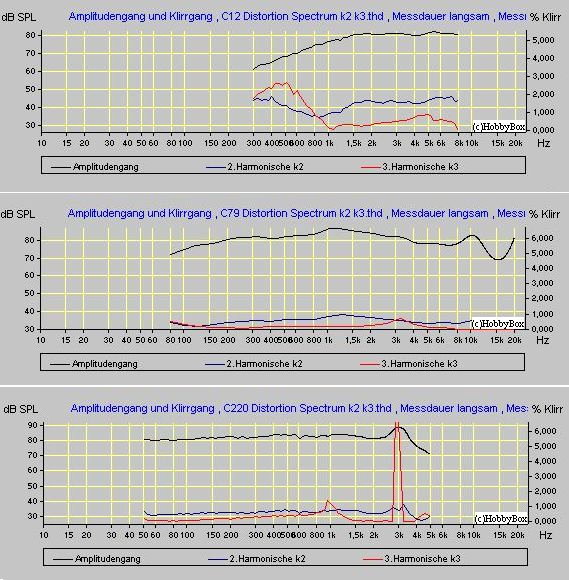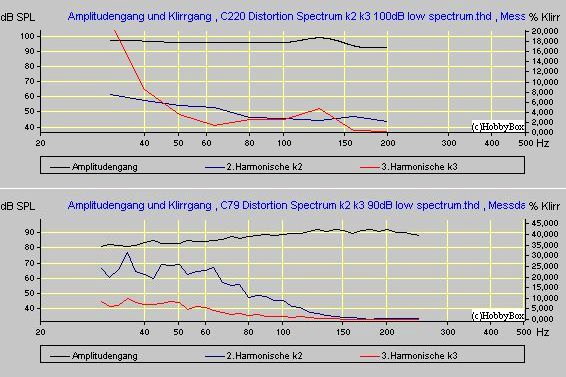
Updated:
14-Sep-03
Gydinel
First measurements in final enclosure without filter
Quick Navigation:
Impedance Curves
Frequency response Curves
k2 k3 Distortion Curves (80dB SPL
range)
k2 k3 Distortion
Curves (C220 C79 bass at high SPL levels)
k2 k3 Distortion
Curves Subwoofer (90dB/100dB SPL levels)
Conclusions and next steps........

OK, here we go!. First I measured the units without filters to have an idea of their behavior in the enclosure which should lead to ideas on what filter configuration to use.... First of all the impedance curves of the 3 units with enclosures (The tweeter is already on the spec page...)
What observations did I made?
# At least the enclosures and units seems to match very well....
# Fs as expected; 45, 45 en 140 Hz. Together with the resonance-peaks this will result in a Qbox of aprox 0,55 - 0,60 in all 3 cases. Hobby Box is not 100% clear here as you have to do a reference measurement in another enclosure. Bit too much hassle.... But this is a good interpretation, together with the manual calculations I made... This will represent practice quite good
# With the C220, a strong resonance peak at 3kHz, pfffff very bad......
# The Impedance peak at Fs should not be a problem, as I drive the C220 active, but if in case I would make a 3-way crossover, this will be a difficult issue. MMhhh Active is not so bad, eh? Solves problems upfront :-)

For the frequency response curves, I have chosen for near-field measurements. Unfortunately I have no un-echoic-room, so I need to avoid in one way or another early reflections from the impulse signal, HobbyBox is working with. In my livingroom this will work till a FFT# of 256. This will allow accurate measurements starting at aprox 200-300Hz. BUT I wanted also the low frequencies now !!! The solution is relatively simple. You just shift the microphone closer and closer to the LS unit, till you don't see the reflections any more at an FFT of aprox 2048. In my case this was 10cm. The curves represent not 100% a dead room, but for my purpose, the behavior in the enclosure and the unveiling of problem areas, this proofs to be sufficient !
OK, enough background, what are the observations ???
# First the black curve, de C220. Nicely flat and linear. Straight till 45Hz, no peak no dip. The midrange is slowly going up due too the baffle step wit aprox 5dB. But then: A really brutal cone resonance (breakup) at 3kHz. Also clearly audible. Sure to stay out of this area. I would not choose this unit for a 2 way system..... For the rest TEXTBOOK !!
# The Green one, C79. Under 150Hz quickly going down; indeed not to be used as low/mid unit and also not in a mode where the as mid range unit, the bass is just rolling naturally. This will induce too much distortion. A small hick up at 800 Hz (??) and also clearly the 5dB uplift due too the baffle step... With the small top enclosures in the line of expectations. This could be well compensated by the inductor in the filter together with the C220, who will fill in the "gap", also rolling of with 6dB in that area, so a kind of acoustical compensation. Advantage: No SPL lost !!! Normally compensating baffle step cost 4-6 dB SPL !!!!
# The C79 has a very relaxed and smooth roll off beyond 2kHz and a nasty peak at 10kHz. Very nice, this is a factor 4 beyond the take over frequency...... Should be relatively easy to filter this away.... But, I should not use it beyond 3kHz without 12dB damping. Any way, beyond 3-4 kHz the unit, because of its diameter will start bundling, so not the place to be !! I will keep this few options in mind for the filter tests !!
# The red hot curve of the C12: wow ! this is real class!! very smooth roll off with no peaks, no dips, no nothing..... A softdome tweeter can only dream from such behavior ! The ceramic cone is clearly paying of here !! With a curve like this I would opt quickly for 6dB. Why 12dB? The tweeter is climbing up at the end of the spectrum. This is something I need to carefully keep an eye on. It could make the speaker too brilliant, leading to listening fatigue....Oh, the roll off beyond 15kHz is clearly my soundcard.... We KNOW the unit goes straight to > 30kHz !!!
Actually very satisfying results !! Just a few relatively small problem areas, but nothing we cannot handle, without the need to make us of very high order filters and zobel networks... So we now defined more or less the usable range of the units in the enclosures. Lets check if the units will work distortion free in that range to complete this topic !!!
k2 k3 Distortion Curves (80dB SPL range)

Distortion (at 80dB) conclusions
First picked the mid/high range to investigate at a reasonable level of 80dB. Why so low?? Well it is not THAT low eh? Besides, if I find problem areas at 80dB I know for sure to do something about it !! Doing this at 90 or 100dB is not wise. You will find too many problems, haha! No just kidding, but if you find problems at 80 dB, you know you will have them above as well, agree?
# The C12: Clear case, first under 800Hz distortion goes rapidly up. This is a really good score !! De k2 of 1.5% is not as bad as you might think thanks too its even character. The k3 is worse, sound like square waves, haha! So need to stay at least 10dB away from the 800 Hz. Therefore minimally take over beyond 2kHz. If you would go 12 dB you could go easy 500Hz lower if needed. But do I need this??? Don't think so...... but good to know the boundaries of the playing field..... Based on this you would start thinking on a very "safe" combination of 6dB / 12dB combination (6dB for the C12 and consequently 12dB for the C79)
#The C79 is a real jewel (above 100Hz and at 80 dB… read the next paragraph as well !!!) But for mid/high, I foresee no issues in regard to the k2 and k3
# Same for the C220 Small peak at 1kHz. The real bad thing is the 3kHz peak, 10% at 80dB is really real bad, BRRRRRRR ..... Stay OUT !!! May be a resonance absorber (serial circuit LCR) at 3kHz Not on top of the list, but may be useful as experiment later...
Every thing more or less "green light" as long as you stay away from the 3 and 10kHz .....
k2 k3 Distortion Curves (C220 C79 bass at high SPL levels)

Distortion (Low frequencies at high SPL) conclusions
Ofcourse I used for this measurement the more realistic SPL of 90 and 100dB !!
# Torturing the C220 at almost 100dB; No surprise the distortion under fc is growing exponentially strong !! No wonder with closed enclosure and a 20cm unit with very soft suspension. I am not sure if I need some kind of rumble filter in the TUMOS to compensate. But I am afraid I will loose the "kick" which is coming so smoothly from the C220. We will put this is on the back of the list :-) Again, do not forget, this is really loud !!! (100dB)
# The C79 is clearly dead duck under 150Hz when we play 90dB. Totally unacceptable to use a natural roll off here !! To be honest, this is exactly what I am doing already. A RC in the Tune amp with fc of 160Hz... Effectively keeping the basses and k2k3 out...
May be I need to add an extra pole as 20% distortion at 70Hz is really bad.... May be at half fc of the Tube amp( so 80Hz)
k2 k3 Distortion Curves Subwoofer (90dB/100dB SPL levels)

Distortion (SUB-Woofer at high SPL)
# First test at 90dB is to soft for these steam machines, haha!! Just look at the incredible low k2k3. It is clear (and of course designed to be so...) that the 2 12" units are playing "left-handed"....
# OK, Lets work than !!! 100dB .... This curves were actually made with the bass boost at 6dB at25Hz. Normally your cone lies in the listening position :-) NOT with the Eton... values of 5 and even 10% are complete "normal" and it is said that at these frequencies you will not hear the distortion. Any way, values like this at 100dB are just perfect. Indeed this is a nice sub bass(understatement, haha)
Conclusions and next steps........
Mission completed. The units are really to be classified as high end. Almost no real comments to be made. I have a good idea of the behavior of the units and the problem areas. Already thought of a few ideas for the cross over. So nothing stops me now to start work with the filters !
I think I will start with a standard 6dB Serial filter and make a 6dB / 12dB variant. So we can do some measuring and listening tests.
Happy listening and building !!
Doede Douma
IMPORTANT: The information provided on this page is intended as guide for DIY activities and therefore free to copy and or publish. If any one wishes to use any of the information from my WEB site, please make sure to refer and footnote to my URL Link as source! Doede Douma